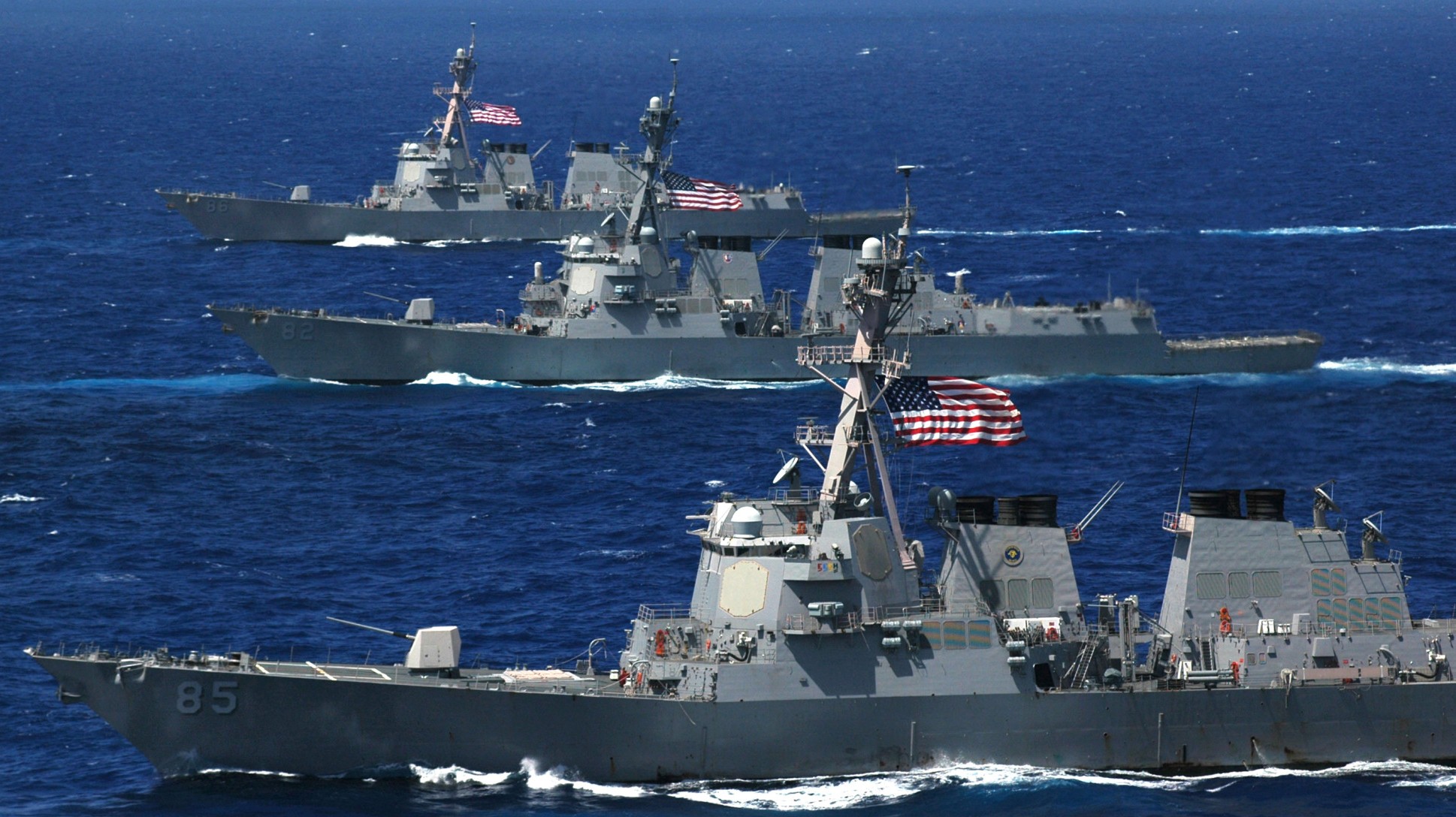 |
|||
|
HOME
|
US Navy -
ships
|
US Navy - air
units
|
USMC - air
units
|
International
Navies
|
Weapon Systems
|
Special Reports |
|||
|
US Navy Arleigh Burke class Guided Missile Destroyer - DDG |
|||
|
|||
| Ships: | |||
|
Flight I: DDG 51 USS Arleigh Burke (1991) DDG 52 USS Barry (1992) DDG 53 USS John Paul Jones (1993) DDG 54 USS Curtis Wilbur (1994) DDG 55 USS Stout (1994) DDG 56 USS John S. McCain (1994) DDG 57 USS Mitscher (1994) DDG 58 USS Laboon (1995) DDG 59 USS Russell (1995) DDG 60 USS Paul Hamilton (1995) DDG 61 USS Ramage (1995) DDG 62 USS Fitzgerald (1995) DDG 63 USS Stethem (1995) DDG 64 USS Carney (1996) DDG 65 USS Benfold (1996) DDG 66 USS Gonzalez (1996) DDG 67 USS Cole (1996) DDG 68 USS The Sullivans (1997) DDG 69 USS Milius (1996) DDG 70 USS Hopper (1997) DDG 71 USS Ross (1997) Flight II: DDG 72 USS Mahan (1998) DDG 73 USS Decatur (1998) DDG 74 USS McFaul (1998) DDG 75 USS Donald Cook (1998) DDG 76 USS Higgins (1999) DDG 77 USS O’Kane (1999) DDG 78 USS Porter (1999) Flight IIA: Flight IIA ships - with 5"/54 gun DDG 79 USS Oscar Austin (2000) DDG 80 USS Roosevelt (2000) Flight IIA ships - with 5"/62 gun DDG 81 USS Winston S. Churchill (2001) DDG 82 USS Lassen (2001) DDG 83 USS Howard (2001) DDG 84 USS Bulkeley (2001) DDG 85 USS McCampbell (2002) DDG 86 USS Shoup (2002) DDG 87 USS Mason (2003) DDG 88 USS Preble (2002) DDG 89 USS Mustin (2003) DDG 90 USS Chafee (2003) DDG 91 USS Pinckney (2004) DDG 92 USS Momsen (2004) DDG 93 USS Chung Hoon (2004) DDG 94 USS Nitze (2005) DDG 95 USS James E. Williams (2004) DDG 96 USS Bainbridge (2005) DDG 97 USS Halsey (2005) DDG 98 USS Forrest Sherman (2006) DDG 99 USS Farragut (2006) DDG 100 USS Kidd (2007) DDG 101 USS Gridley (2007) DDG 102 USS Sampson (2007) DDG 103 USS Truxtun (2009) DDG 104 USS Sterett (2008) DDG 105 USS Dewey (2010) DDG 106 USS Stockdale (2009) DDG 107 USS Gravely (2010) DDG 108 USS Wayne E. Meyer (2009) DDG 109 USS Jason Dunham (2010) DDG 110 USS William P. Lawrence (2011) DDG 111 USS Spruance (2011) DDG 112 USS Michael Murphy (2012) Flight IIA ships - restart DDG 113 USS John Finn (2017) DDG 114 USS Ralph Johnson (2018) DDG 115 USS Rafael Peralta (2017) Flight IIA ships - technology insertion DDG 116 USS Thomas Hudner (2018) DDG 117 USS Paul Ignatius (2019) DDG 118 USS Daniel Inouye (2021) DDG 119 USS Delbert D. Black (2020) DDG 120 USS Carl M. Levin (2023 ?) DDG 121 USS Frank E. Petersen Jr. (2022) DDG 122 USS John Basilone (?) DDG 123 USS Lenah H. Sutcliffe Higbee (2023) DDG 124 USS Harvey C. Barnum Jr. (?) DDG 127 USS Patrick Gallagher (?) Flight III: DDG 125 USS Jack H. Lucas (2023) DDG 126 USS Louis H. Wilson Jr. (?) DDG 128 USS Ted Stevens (?) DDG 129 USS Jeremiah Denton (?) DDG 130 USS William Charette (?) DDG 131 USS George M. Neal (?) DDG 132 USS Quentin Walsh (?) DDG 133 USS Sam Nunn (?) DDG 134 USS John E. Kilmer (?) DDG 135 USS Thad Cochran (?) DDG 136 USS Richard G. Lugar (?) DDG 137 USS John F. Lehman (?) DDG 138 USS J. William Middendorf (?) DDG 139 USS Telesforo Trinidad (?) DDG 140 USS Thomas G. Kelley (?) |
|||
| Specifications: | |||
|
|||
|
The Arleigh Burke class of guided missile destroyers (DDGs) is the
United States Navy's first class of destroyer built around the Aegis
Combat System and the SPY-1D multi-function passive electronically
scanned array radar. The class is named for Admiral Arleigh Burke,
the most famous American destroyer officer of World War II, and
later Chief of Naval Operations. The class leader, USS Arleigh
Burke, was commissioned during Admiral Burke's lifetime. They were designed as multi-mission destroyers to fit the anti-aircraft warfare (AAW) role with their powerful Aegis radar and surface-to-air missiles; anti-submarine warfare (ASW), with their towed sonar array, anti-submarine rockets, and ASW helicopter; Anti-surface warfare (ASUW) with their Harpoon missile launcher; and strategic land strike role with their Tomahawk missiles. With upgrades to their to AN/SPY-1 phased radar systems and their associated missile payloads as part of the Aegis Ballistic Missile Defense System, members of this class have also begun to demonstrate some promise as mobile anti-ballistic missile and anti-satellite weaponry platforms. Some versions of the class no longer have the towed sonar, or Harpoon missile launcher. Their hull and superstructure were designed to have a reduced radar cross section. The first ship of the class was commissioned on 4 July 1991. With the decommissioning of the last Spruance-class destroyer, USS Cushing, on 21 September 2005, the Arleigh Burke class ships became the U.S. Navy's only active destroyers; the class has the longest production run for any post-World War II U.S. Navy surface combatant. Besides the 62 vessels of this class (comprising 21 of Flight I, 7 of Flight II and 34 of Flight IIA) in service by 2013, up to a further 42 (of Flight III) have been envisaged. With an overall length of 505 feet (154 m) to 509 feet (155 m), displacement ranging from 8,315 to 9,200 tons, and weaponry including over 90 missiles, the Arleigh Burke class are larger and more heavily armed than most previous ships classified as guided missile cruisers. The ships of the Arleigh Burke-class are among the largest destroyers built in the United States. Only the Spruance class, Kidd class (563 feet /172 m) and Zumwalt class (600 feet /180 m) were longer. The larger Ticonderoga-class ships were constructed on Spruance-class hull forms, but are designated as cruisers due to their radically different mission and weapons systems than the Spruance and Kidd class destroyers. The Arleigh Burke class on the other hand were designed with a new, large, water-plane area-hull form characterized by a wide flaring bow which significantly improves sea-keeping ability. The hull form is designed to permit high speed in high sea states. The Arleigh Burke's designers incorporated lessons learned from the Ticonderoga class guided-missile cruisers, the latter which was deemed too expensive to continue building and too difficult to further upgrade. With the Arleigh Burke class, the U.S. Navy also returned to all-steel construction. An earlier generation had combined a steel hull with an innovative superstructure made of lighter aluminum to reduce top weight, but the lighter metal proved vulnerable to cracking. Aluminum is also less fire-resistant than steel; a 1975 fire aboard USS Belknap gutted her aluminum superstructure. Battle damage to Royal Navy ships exacerbated by their aluminum superstructures during the 1982 Falklands War supported the decision to use steel. Another lesson from the Falklands War led the navy to protect the ship's vital spaces with double-spaced steel armor (creating a buffer for modern rockets), and kevlar spall liners. The Arleigh Burke design incorporates stealth techniques, such as the angled rather than traditional vertical surfaces and the tripod mainmast, which make the ship more difficult to detect, in particular by anti-ship missiles. A Collective Protection System makes the Arleigh Burke class the first U.S. warships designed with an air-filtration system against nuclear, biological and chemical warfare. Other NBC defenses include a "countermeasure wash down system". Their AEGIS Combat System differs from a traditional rotating radar that mechanically rotates 360 degrees for each sweep scan of the airspace. Instead, Aegis uses a passive electronically scanned arrays, which allow continual tracking of targets simultaneous with area scans. The system's computer control also allows centralization of the previously separate tracking and targeting functions. The system is also resistant to electronic counter-measures. Their standalone Harpoon anti-ship missile launchers give them an anti-ship capability with a range in excess of 64 nautical miles (119 km; 74 mi). With the retirement of the Tomahawk anti-ship missile variant, only Arleigh Burke-class ships before Flight IIA versions are well-equipped for anti-surface warfare with Harpoon launchers. Others are not, but are loaded with SM-2 missiles in their vertical launch cells capable of an anti-ship mode, though they have limited range and damage potential. "The 5-inch/54 caliber Mark 45 gun, in conjunction with the Mark 34 Gun Weapon System, is an anti-ship weapon which can also be used for close-in air contacts or to support forces ashore with Naval Gun-Fire Support (NGF), with a range of up to 20 miles (32 km) and capable of firing 20 rounds per minute." The class's RIM-7 Sea Sparrow/RIM-162 ESSM missiles provide point defense against missiles and aircraft while the Standard Missile 2 and 6 provide area anti-aircraft defense; the SM-6 provides over the horizon missile defense. The Standard Missile 3 and 6 also provide Ballistic Missile Defense (BMD). The ship has an electronics warfare suite that provides passive detection and decoy countermeasures. The class's Light Airborne Multi-Purpose System (LAMPS) helicopter system improves the ship's capabilities against submarines and surface ships, a helicopter able to serve as a platform to monitor submarines and surface ships, and launch torpedoes and missiles against them, as well as being able to support ground assaults with machine guns and Hellfire anti-armor guided missiles. The helicopters also serve in a utility role, able to perform ship replenishment, search and rescue, medical evacuation, communications relay, and naval gunfire spotting and controlling. The Arleigh Burke class are multi-mission ships with numerous combat systems, including a "combination of... an advanced anti-submarine warfare system, land attack cruise missiles, ship-to-ship missiles, and advanced anti-aircraft missiles," Burkes have the Navy's latest anti-submarine combat system with active sonar, a towed sonar array, and anti-submarine rockets. They support strategic land strikes with their VLS launched Tomahawks. They are able to detect anti-ship mines at a range of 1400 yards. So vital has the Aegis Ballistic Missile Defense System (BMD) role of the class become that all ships of the class are being updated with BMD capability. Burke production is being restarted in place of additional Zumwalt-class destroyers. Development: In 1980, the U.S. Navy initiated design studies with seven contractors. By 1983 the number of competitors had been reduced to three: Bath Iron Works, Todd Shipyards and Ingalls Shipbuilding. On 3 April 1985 Bath Iron Works received a US$321.9 million contract to build the first of class, USS Arleigh Burke. Gibbs & Cox was awarded the contract to be the lead ship design agent. The total cost of the first ship was put at US$1.1 billion, the other US$778 million being for the ship's weapons systems. She was laid down by the Bath Iron Works at Bath, Maine, on 6 December 1988, and launched on 16 September 1989 by Mrs. Arleigh Burke. The Admiral himself was present at her commissioning ceremony on 4 July 1991, held on the waterfront in downtown Norfolk, Virginia. The "Flight IIA Arleigh Burke" ships have several new features, beginning with the USS Oscar Austin (DDG-79). Among the changes are the addition of two hangars for ASW helicopters, and a new, longer Mark 45 Mod 4 5-inch/62-caliber naval gun (fitted on USS Winston S. Churchill (DDG-81) and later ships). Later Flight IIA ships starting with USS Mustin (DDG-89) have a modified funnel design that buries the funnels within the superstructure as a signature-reduction measure. TACTAS towed array sonar was omitted from Flight IIA ships and they also lack Harpoon missile launchers. Ships from DDG-68 to DDG-84 have AN/SLQ-32 antennas that resemble V3 configuration similar to those deployed on Ticonderoga-class cruisers, while the remainder have V2 variants externally resembling those deployed on some Oliver Hazard Perry-class frigates. V3 has an active electronic countermeasures component while V2 is passive only. AN/SLQ-32 is being upgraded under the Surface Electronic Warfare Improvement Program (SEWIP), the first SEWIP Block 2 upgrades were installed in 2014 with full-rate production scheduled for mid-2015. A number of Flight IIA ships were constructed without a Phalanx CIWS because of the planned Evolved Sea Sparrow Missile, but later the Navy decided to retrofit all IIA ships to carry at least one Phalanx CIWS by 2013. USS Pinckney, USS Momsen, USS Chung-Hoon, USS Nitze, USS James E. Williams and USS Bainbridge have superstructure differences to accommodate the Remote Mine-hunting System (RMS). Mk 32 torpedo tubes were moved to the missile deck from amidships as well. Modernization: The U.S. Navy began a modernization program for the Arleigh Burke class aimed at improving the gun systems on the ships in an effort to address congressional concerns over the retirement of the Iowa-class battleships. This modernization was to include an extension of the range of the 5-inch (127 mm) guns on the flight I Arleigh Burke-class destroyers (USS Arleigh Burke to USS Ross) with extended range guided munitions (ERGMs) that would have given the guns a range of 40 nautical miles (74 km). However, the ERGM was cancelled in 2008. The modernization program is designed to provide a comprehensive mid-life upgrade to ensure that the class remains effective. Reduced manning, increased mission effectiveness, and a reduced total cost including construction, maintenance, and operation are the goals of the modernization program. Modernization technologies will be integrated during new construction of DDG-111 and 112, then retrofitted into DDG flight I and II ships during in-service overhaul periods. The first phase will update the hull, mechanical, and electrical systems while the second phase will introduce an open architecture computing environment (OACE). The result will be improved capability in both ballistic missile defense (BMD) and littoral combat. By 2018 all Burkes homeported in the Western Pacific will have upgraded anti-submarine systems, including the new AN/SQR-20 Multifunction Towed Array. The Navy is also upgrading the ships' ability to process data. Beginning with USS Spruance, the Navy is installing an internet protocol (IP) based data backbone, which enhances the ship's ability to handle video. Spruance is the first destroyer to be fitted with the Boeing Company's gigabit Ethernet data multiplex system (GEDMS). In July 2010 BAE Systems announced that it had been awarded a contract to modernize 11 ships. In May 2014 Sam LaGrone reported that 21 of the 28 Flight I/II Burkes would not receive a mid-life upgrade that included electronics and Aegis Baseline 9 software for SM-6 compatibility, instead they would retain the basic BMD 3.6.1 software in a US$170m upgrade concentrating on mechanical systems and on some ships, the anti-submarine suite. Seven Flight I ships - DDG 51-53, 57, 61, 65, 69 - will get the full US$270m Baseline 9 upgrade. Deputy of surface warfare Dave McFarland said that this change was due to the budget cuts in the Budget Control Act of 2011. In 2016, the Navy will begin the outfitting of 34 Flight IIA Arleigh Burke vessels with a hybrid-electric drive (HED) to lower fuel costs. While the Burke’s four LM-2500 gas turbines are most efficient at high speeds, an electric motor is to be attached to the main reduction gear to turn the drive shaft to propel the ship at speeds under 13 knots, such as during ballistic missile defense or maritime security operations; use of the HED for half the time could extend time on station by 2.5 days before refueling. Two vessels are planned to be outfitted in 2016, with the rest upgraded at a rate of four per year. Also starting that year, four destroyers patrolling with the U.S. 6th Fleet based in Naval Station Rota, Spain (USS Porter (DDG-78), USS Carney (DDG-64), USS Ross (DDG-71), USS Donald Cook (DDG-75)) will get a self-protection upgrade by replacing a Phalanx CIWS with the SeaRAM, a close-range ship defense system that combines the Phalanx sensor dome with an 11-cell RAM launcher, the first time the system has been paired with an Aegis ship. Production restarted and further development: The class was scheduled to be replaced by Zumwalt-class destroyers beginning in 2020, but an increasing threat from both long- and short-range missiles caused the Navy to restart production of the Arleigh Burke class and consider placing littoral combat mission modules on the new ships. In April 2009 the Navy announced a plan that limited the Zumwalt class to three units while ordering another three Arleigh Burke-class ships from both Bath Iron Works and Ingalls Shipbuilding. In December 2009 Northrop Grumman received a $170.7 million letter contract for DDG-113 long-lead-time materials. Shipbuilding contracts for DDG-113 to DDG-115 were awarded in mid-2011 for US$679.6m–$783.6m; these do not include government-furnished equipment such as weapons and sensors which will take the average cost of the FY2011/12 ships to US$1,842.7m per vessel. DDG-113 to DDG-115 will be "restart" ships, similar to previous Flight IIA ships, but including modernization features such as Open Architecture Computing Environment; DDG-116 to DDG-121 will be "Technology Insertion" ships with elements of Flight III. Flight III proper will begin with the third ship procured in 2016. Flight III ships, construction starting in FY2016 in place of the canceled CG(X) program, have various design improvements including radar antennas of mid-diameter increased to 14 feet (4.3 m) from the previous 12 feet (3.7 m). These Air and Missile Defense Radars (AMDR) use digital beamforming, instead of the earlier passive electronically scanned array radars. However, costs for the Flight III ships increased rapidly as expectations and requirements for the program have grown. In particular, this was due to the changing requirements needed to carry the proposed Air and Missile Defense Radar system required for the ships' ballistic missile defense role. The Government Accountability Office found that the design of the Flight IIIs was based on "a significantly reduced threat environment from other Navy analyses" and that the new ships would be "at best marginally effective". The U.S. Navy disagrees with the GAO findings, claiming the DDG-51 hull is "absolutely" capable of fitting a large enough radar to meet requirements. Installation of the AMDR would require double the power and double the cooling, but there is room to fit what is needed inside the hull. In spite of the production restart, the U.S. Navy is expected to fall short of its requirement for 94 missile-defense-capable destroyer and cruiser platforms starting in FY 2025 and continuing past the end of the 30-year planning window. While this is a new requirement as of 2011, and the U.S. Navy has never had so many large missile-armed surface combatants, the relative success of the Aegis ballistic missile defense system has shifted this national security requirement onto the U.S. Navy. The shortfall will arise as older platforms that have been refitted to be missile-defense-capable (particularly the cruisers) are retired in bulk before new destroyers are planned to be built. The U.S. Navy was considering extending the acquisition of Arleigh Burke-class destroyers into the 2040s, according to revised procurement tables sent to Congress, which have the U.S. Navy procuring Flight IV ships from 2032 through 2041. However this was canceled to cover the cost of the Ohio Replacement Submarine, with the air defense commander role retained on one cruiser per carrier battle group. Future replacement: USS Michael Murphy was originally intended to be the last of the Arleigh Burke class. However, with reduction of the Zumwalt-class production, the U.S. Navy requested new DDG-51-class ships. Long-lead materials contracts were awarded to Northrop Grumman in December 2009 for DDG-113 and in April 2010 for DDG-114. General Dynamics received a long-lead materials contract for DDG-115 in February 2010. It is anticipated that in FY2012 or FY2013, the U.S. Navy will commence detailed work for a Flight III design and request 24 ships to be built from 2016 to 2031. In May 2013, a total of 76 Burke-class ships was planned. The Flight III variant is in the design phase as of 2013. In June 2013, the U.S. Navy awarded $6.2 billion in destroyer contracts. Up to 42 Flight III ships may be procured by the U.S. Navy with the first ship entering service in 2023. In April 2014, the U.S. Navy began the early stages of developing a new destroyer to replace the Arleigh Burke-class called the "Future Surface Combatant". The new class is expected to enter service in the early 2030s and initially serve alongside the 22 Flight III DDGs. No hull design or shape has been speculated yet, although the destroyer class will incorporate emerging technologies like lasers, on-board power-generation systems, increased automation, and next-generation weapons, sensors, and electronics. They will leverage technologies in use on other platforms such as the Zumwalt-class destroyer, Littoral Combat Ship, and Gerald R. Ford-class aircraft carriers. The Future Surface Combatant may place importance on the Zumwalt-class destroyer's electric drive system that propels the ship while generating 58 megawatts of on-board electrical power, levels required to operate future directed energy weapons. Laser weapon systems are likely to become more prominent to engage threats without using missiles that could potentially cost more than the target it is engaging. Less costly weapon systems may help keep the destroyer class from becoming too expensive. Initial requirements for the Future Surface Combatant will emphasize lethality and survivability, as well as being able to continue to protect aircraft carriers. The ships also have to be modular to allow for inexpensive upgrades of weaponry, electronics, computing, and sensors over time as threats evolve. The Aegis Combat System (ACS): ... is an advanced command and control (command and decision, or C&D, in Aegis parlance) and weapon control system (WCS) that uses powerful computers and radars to track and guide weapons to destroy enemy targets. The ACS is composed of the Aegis Weapon System (AWS), the fast-reaction component of the Aegis Anti-Aircraft Warfare (AAW) capability, along with the Phalanx Close In Weapon System (CIWS), and the Mark 41 Vertical Launch System. Mk 41 VLS adopts a modular design concept, which results in different versions that vary in size and weight. The length comes in three sizes: 209 in (5.3 m) for the self-defense version, 266 in (6.8 m) for the tactical version, and 303 in (7.7 m) for the strike version. The empty weight for an 8-cell module is 26,800 lb (12,200 kg) for the self-defense version, 29,800 lb (13,500 kg) for the tactical version, and 32,000 lb (15,000 kg) for the strike version, thus incorporating anti-submarine warfare (ASW) systems and Tomahawk Land Attack Cruise Missiles (TLAM). Shipboard torpedo and naval gunnery systems are also integrated. AWS, the heart of Aegis, comprises the AN/SPY-1 Radar, MK 99 Fire Control System, WCS, the Command and Decision Suite, and SM-2 Standard Missile family of weapons; these include the basic RIM-66 Standard, the RIM-67 extended range missile, and the newer RIM-161 designed to counter ballistic missile threats. A further SM-2 based weapon, the RIM-174 Standard ERAM is currently in testing, and may be integrated into the system in the near future. Individual ships may not carry all variants; weapons load-outs are adjusted to suit assigned mission profile. The Aegis Combat System is controlled by an advanced, automatic detect-and-track, multi-function three-dimensional passive electronically scanned array radar, the AN/SPY-1. Known as "the Shield of the Fleet", the SPY high-powered (6 megawatt) radar is able to perform search, tracking, and missile guidance functions simultaneously with a track capacity of well over 100 targets at more than 100 nautical miles (190 km). However the AN/SPY-1 Radar is mounted lower than the AN/SPS-49 radar system and so has a reduced radar horizon. The Aegis system communicates with the Standard missiles through a radio frequency (RF) uplink using the AN/SPY-1 radar for mid-course update missile guidance during engagements, but still requires the AN/SPG-62 radar for terminal guidance. This means that with proper scheduling of intercepts, a large number of targets can be engaged simultaneously. The computer-based command-and-decision element is the core of the Aegis Combat System. This interface makes the ACS capable of simultaneous operation against almost all kinds of threats. The Aegis Ballistic Missile Defense System (BMD) program is intended to enable the Aegis system to act in a sea-based ballistic missile defense function, to counter short- and medium-range ballistic missiles of the variety typically employed by a number of potential opponent states. As of January, 2014, the US and Japan were the only countries to purchase or deploy the Aegis BMD. source: wikipedia |
|||
|
class + detail images for more images go to the individual ship-site |
|||
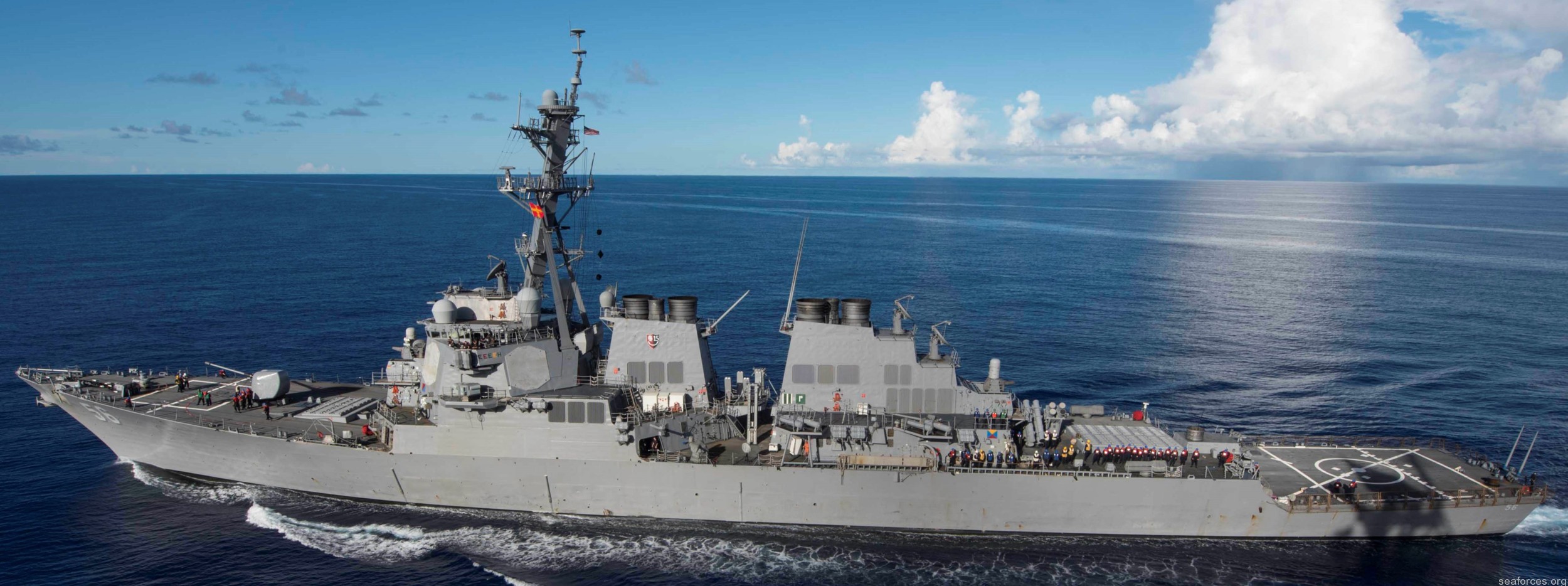 Flight I 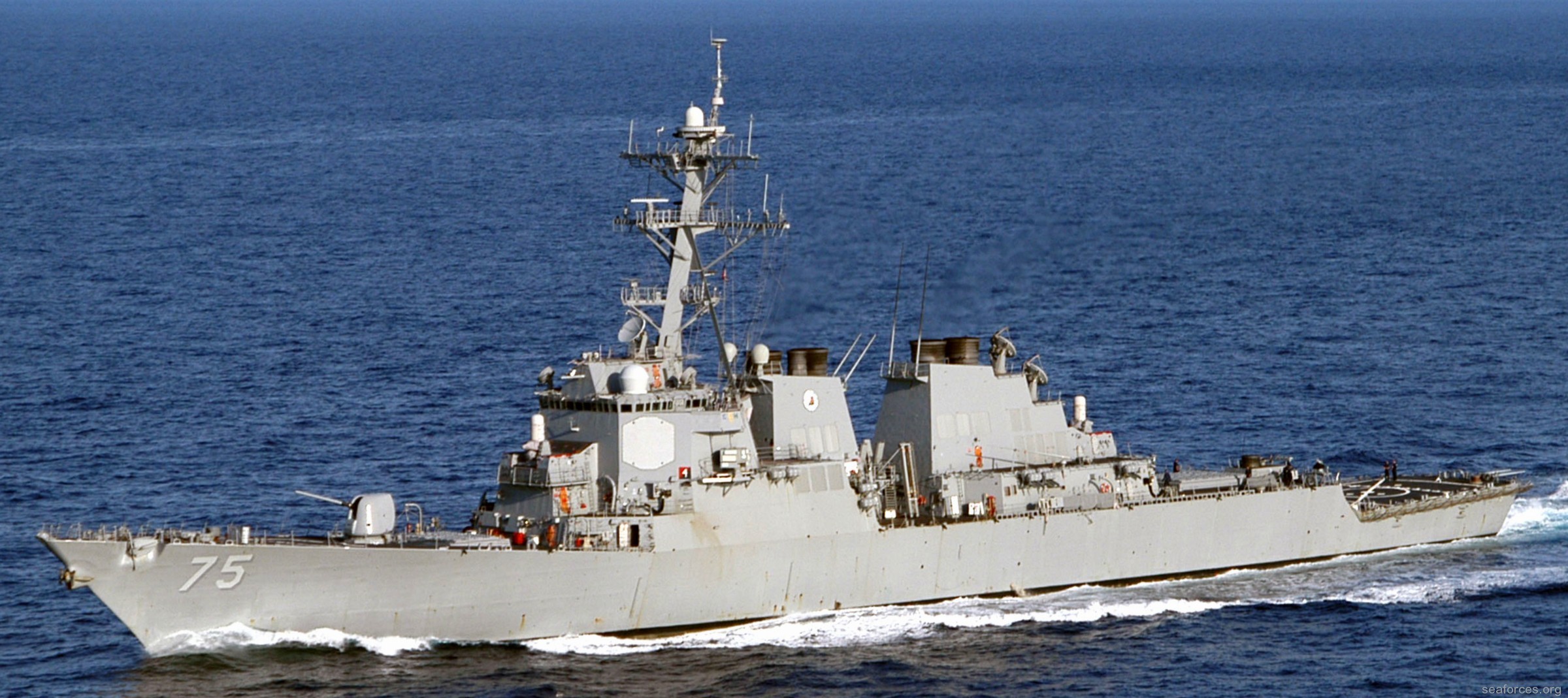 Flight II  Flight IIA 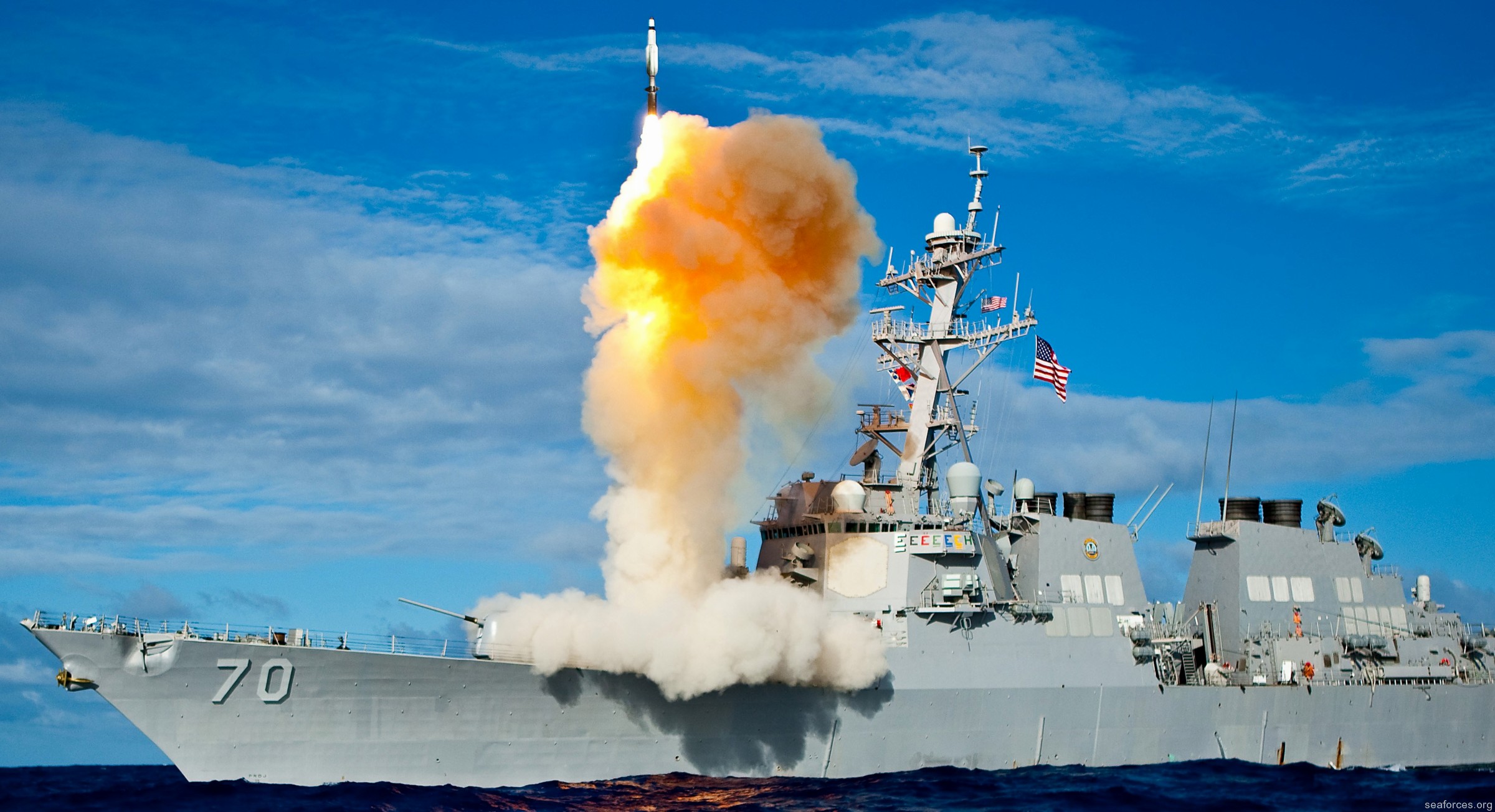 a Standard Missile was fired from the forward Mk-41 VLS 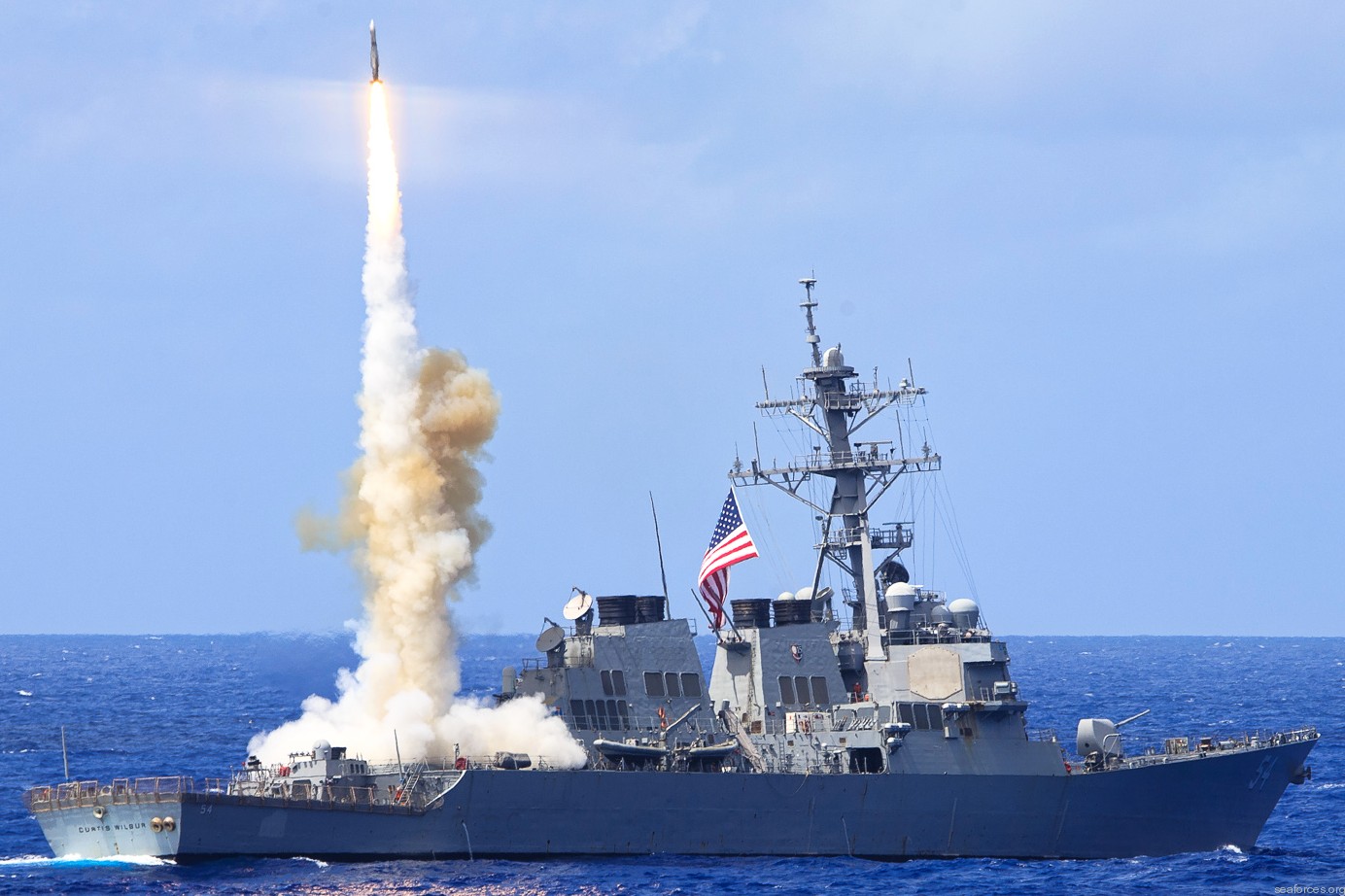 a Standard Missile was fired from the aft Mk-41 VLS 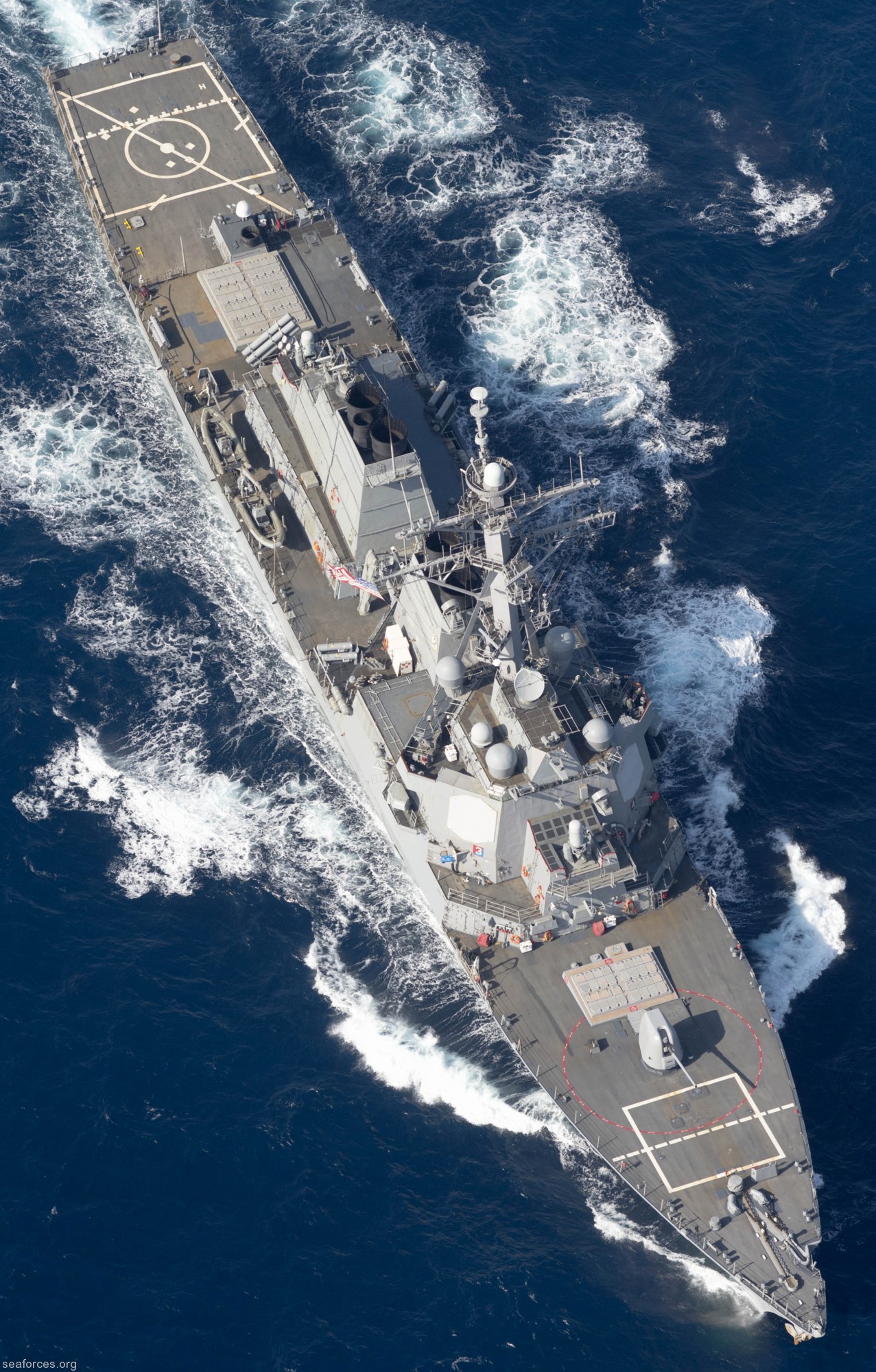 deck details 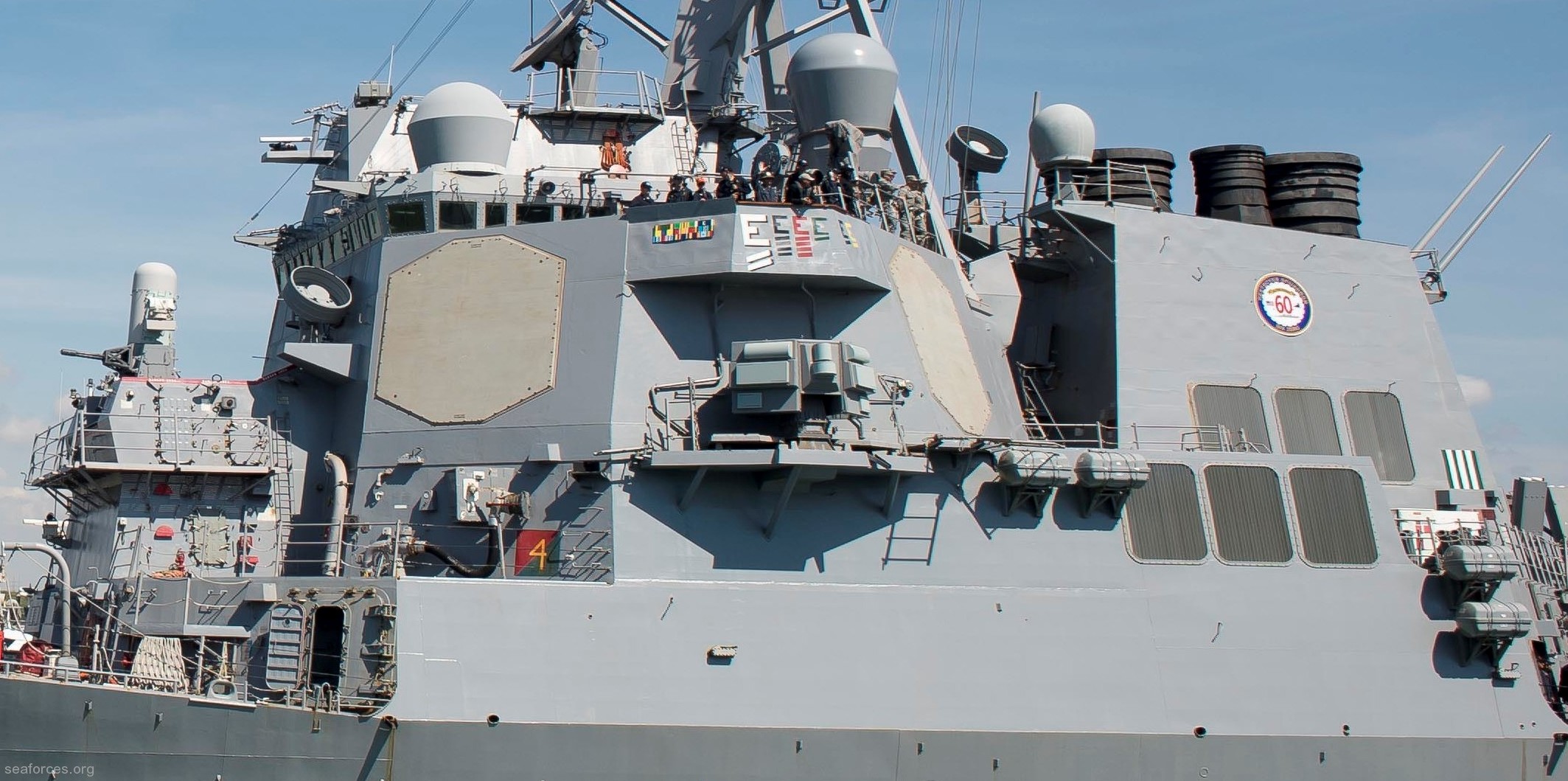 superstructure details 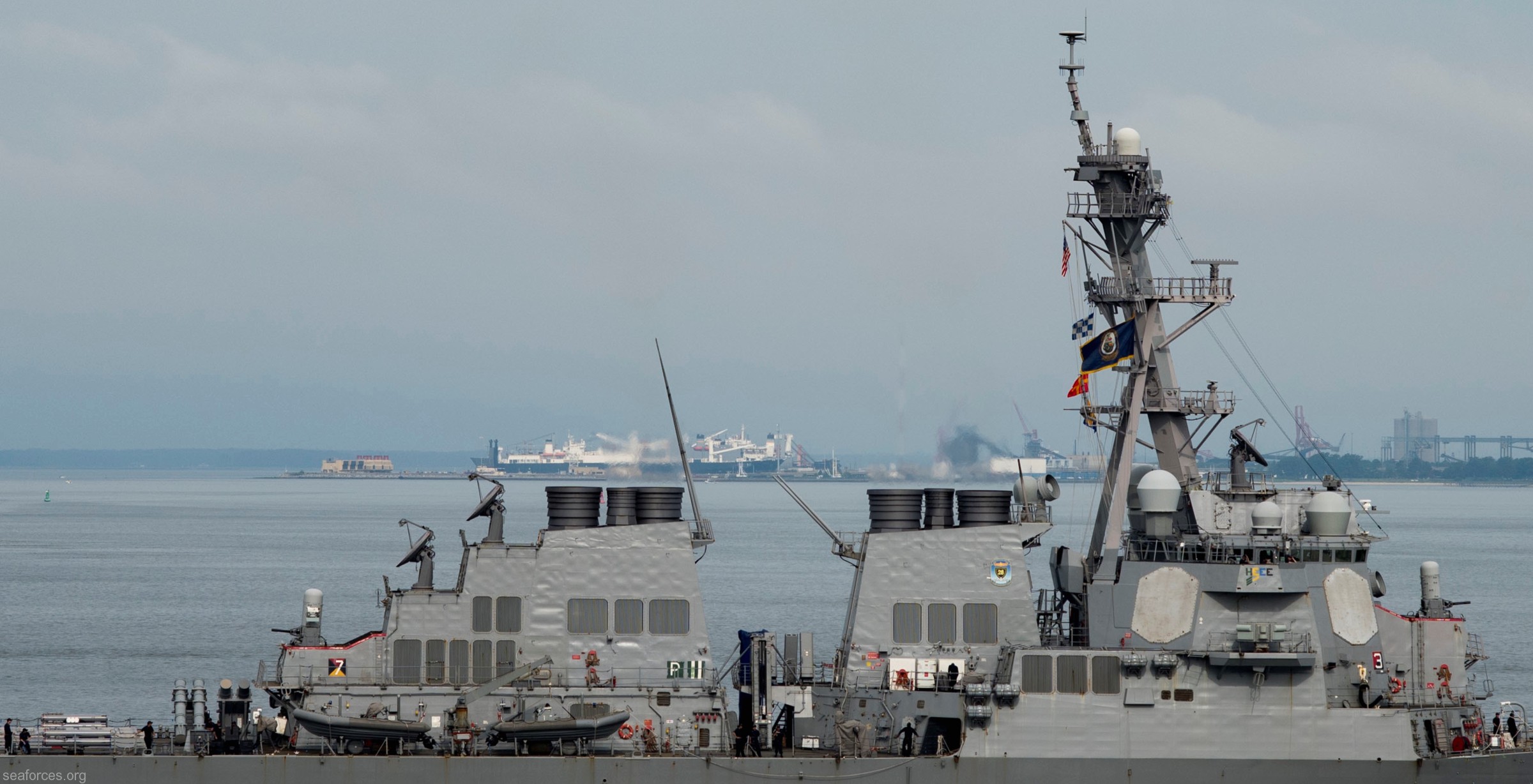 superstructure details 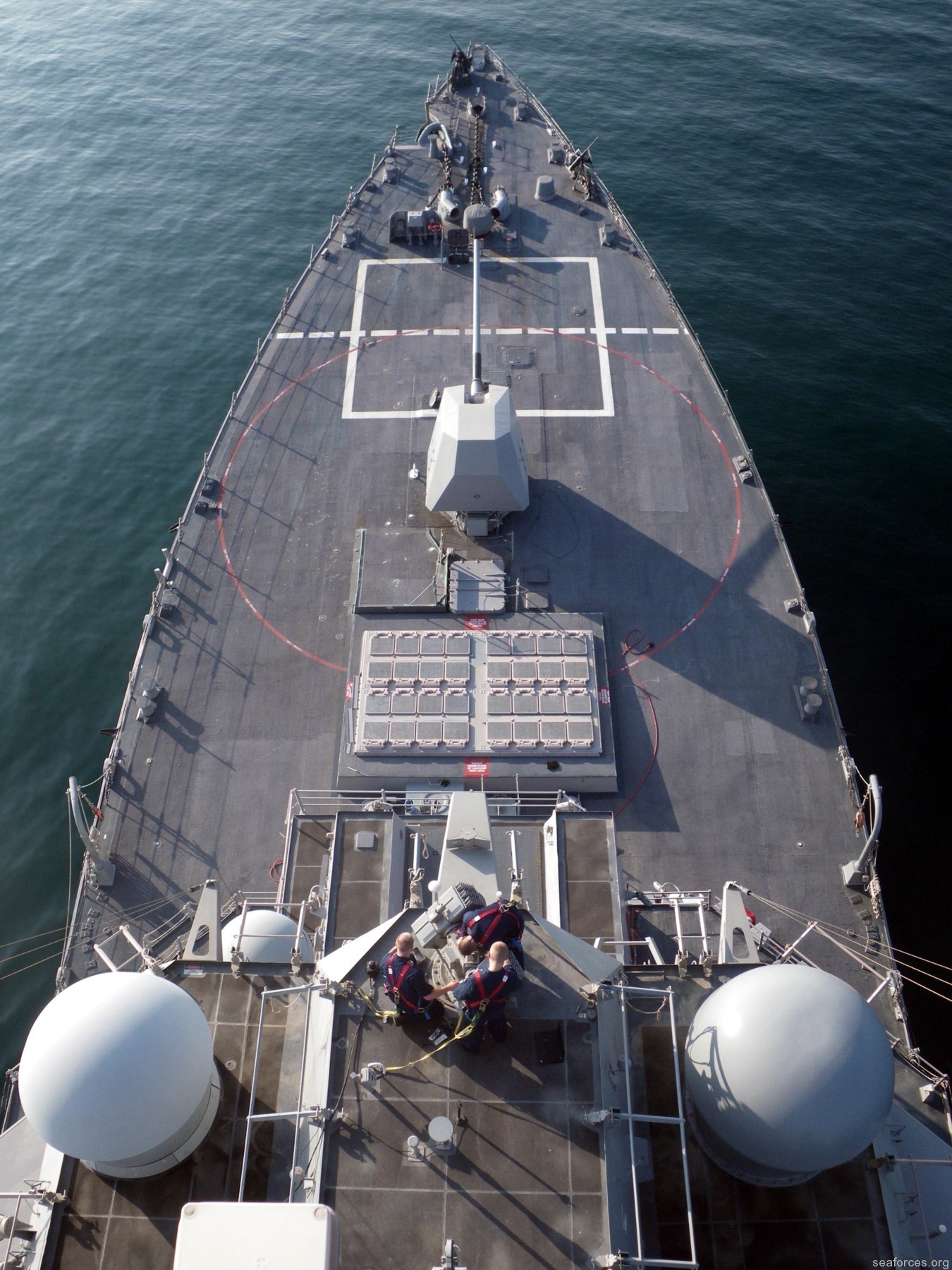 Mk-45 Mod.4 gun and forward Mk-41 Vertical Launching System / VLS 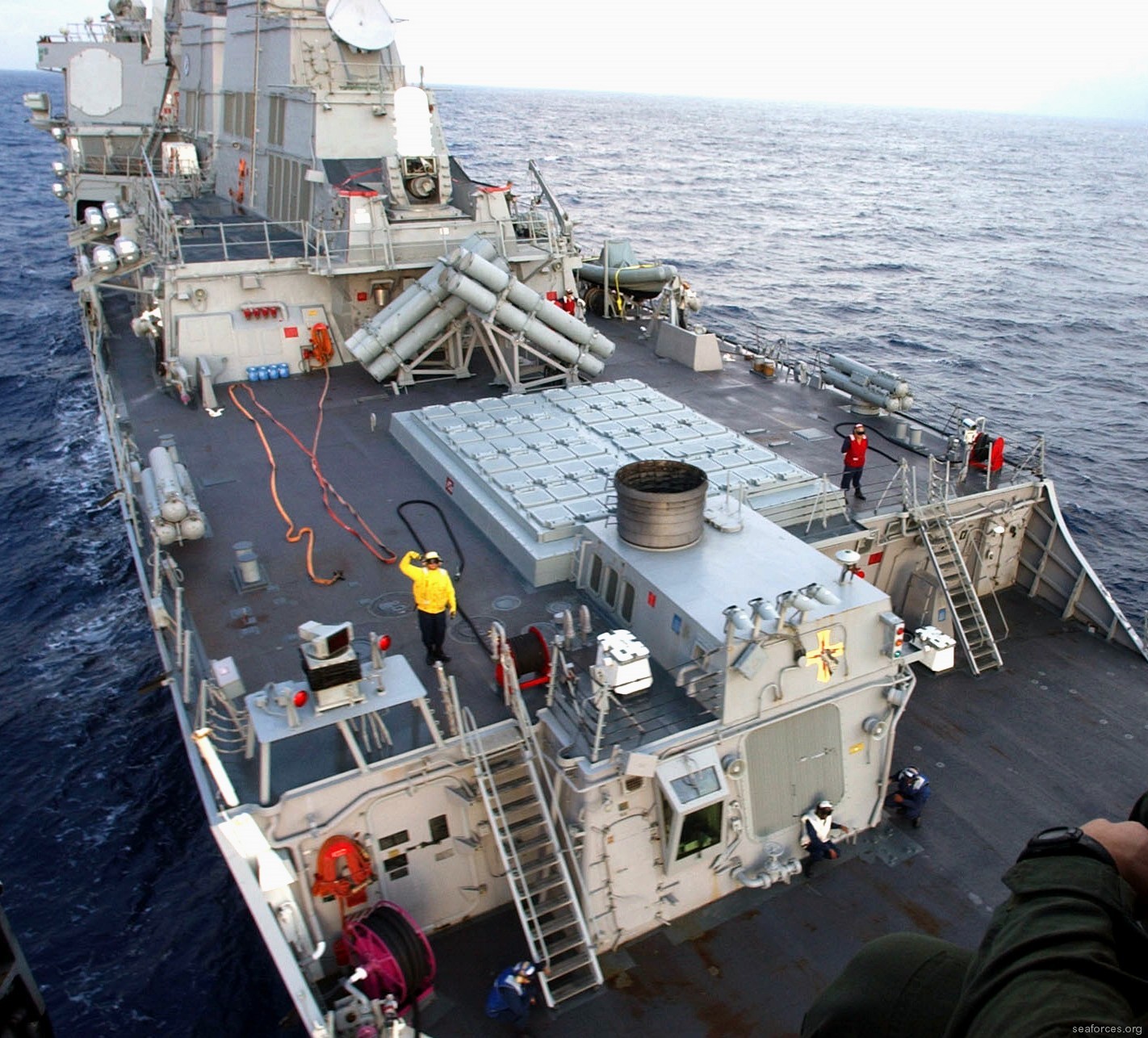 Flight I - aft Mk-41 VLS and Mk-141 HARPOON launcher 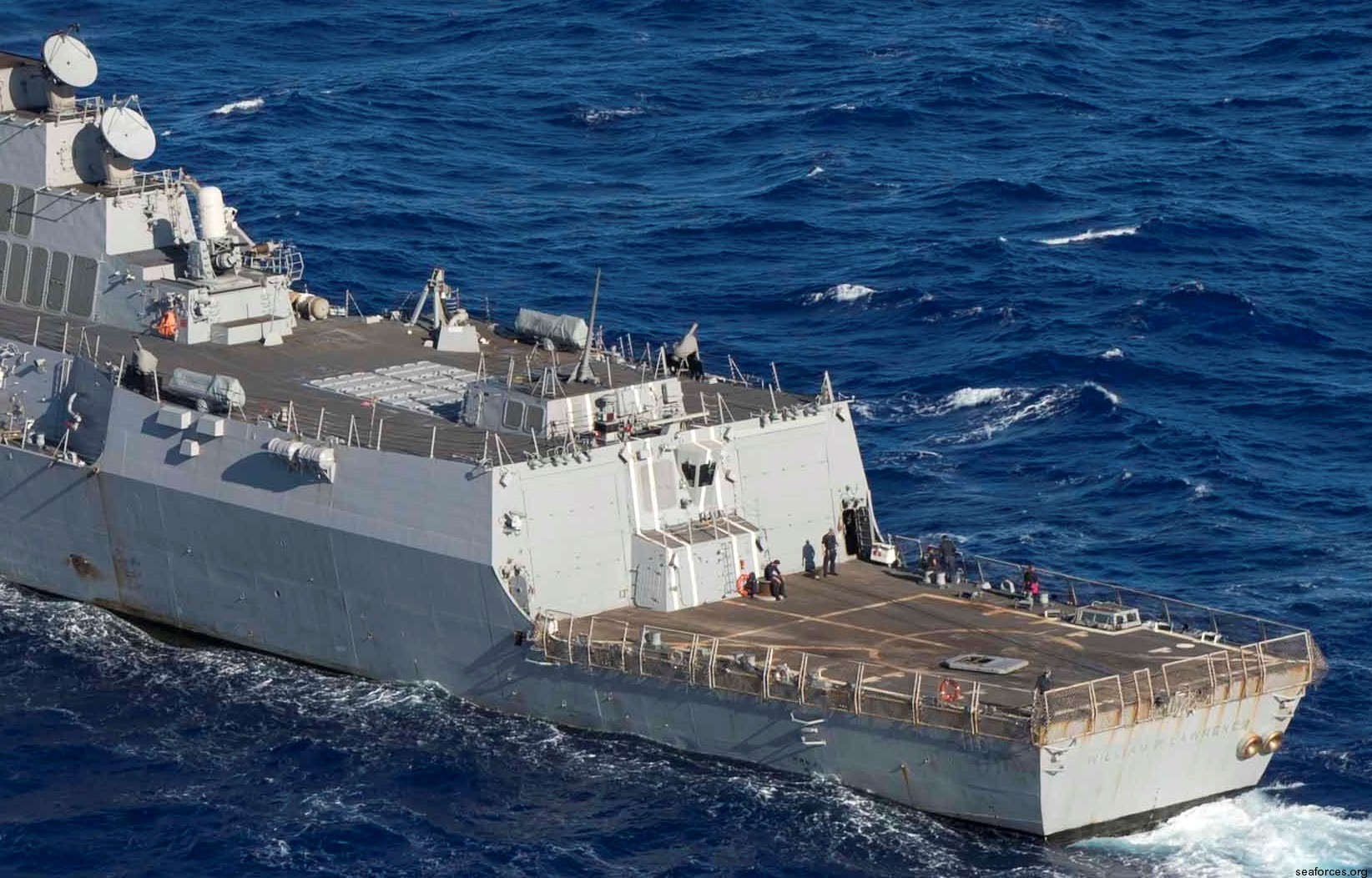 Flight IIA - with 2 hangars class variations: 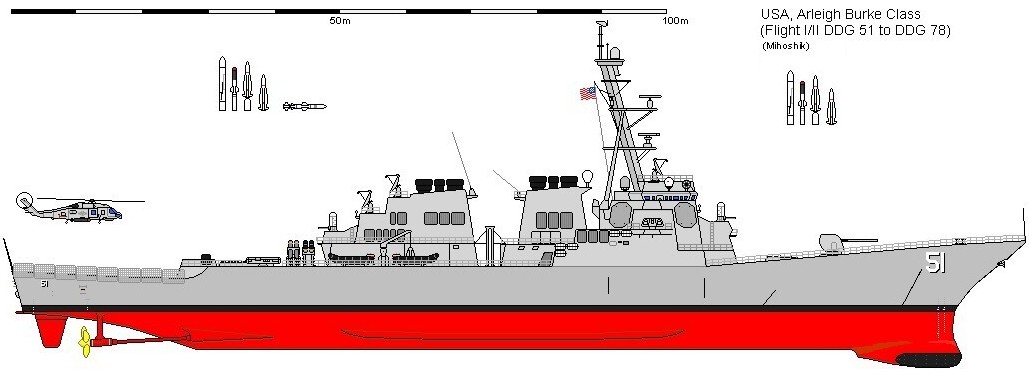 Arleigh Burke class DDG - Flight I & II 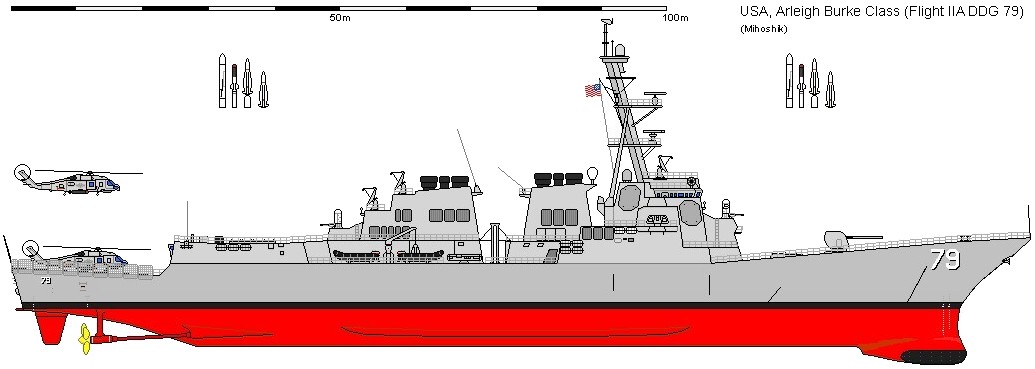 Arleigh Burke class DDG - Flight IIA (with hangar for 2 SH/MH-60 helicopters) 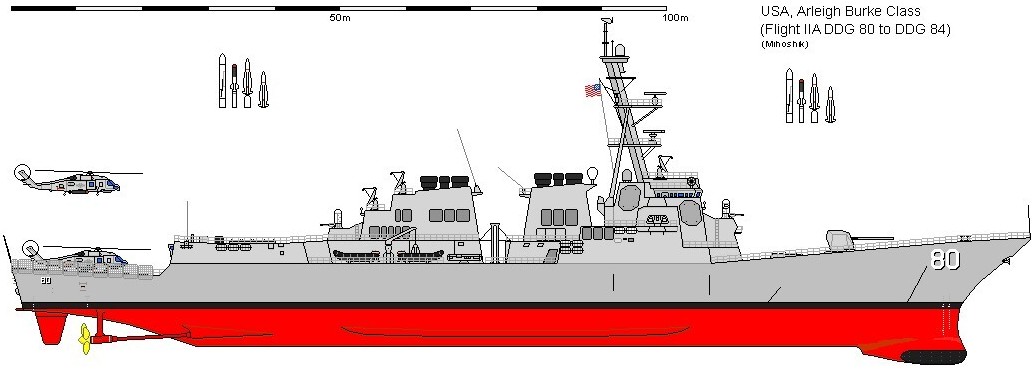 Arleigh Burke class DDG - Flight IIA (with Mk-45 Mod.4 - 5"/62 caliber gun) 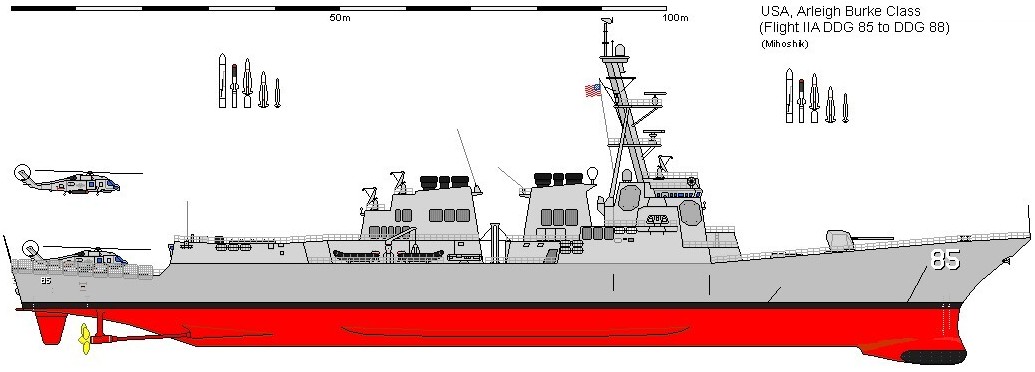 Arleigh Burke class DDG - Flight IIA (without Mk-15 CIWS) 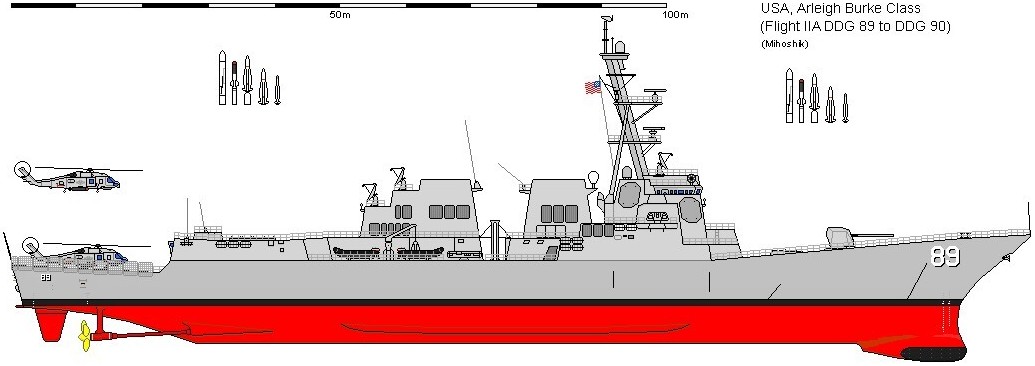 Arleigh Burke class DDG - Flight IIA (with encapsuled funnel) 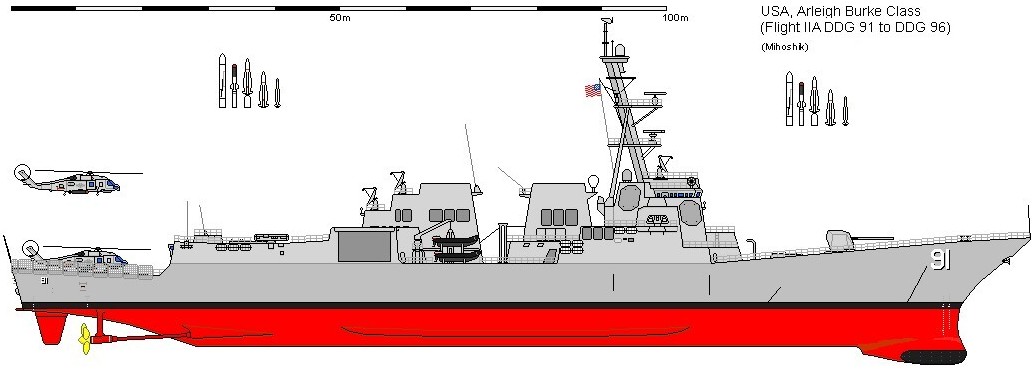 Arleigh Burke class DDG - Flight IIA with modifications for the Remote Mine-hunting System (RMS) (note: the Mk-32 torpedo tubes were moved to the missile deck) 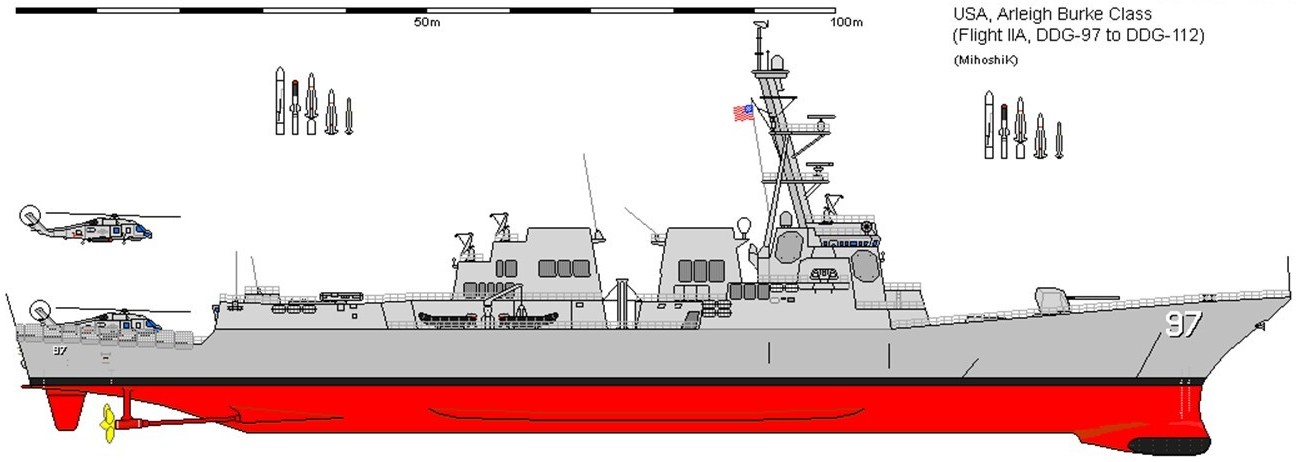 Arleigh Burke class DDG - Flight IIA (Mk-32 torpedo tubes still remained on the missile deck) |
|||
|
|
seaforces.org |
USN ships
start page | |
